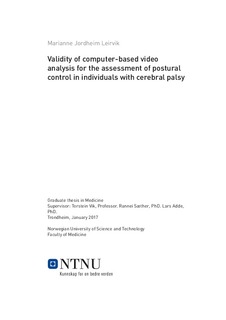| dc.description.abstract | BACKGROUND: Many studies show that individuals with cerebral palsy (CP) have problems with postural control, which is important for the ability to carry out day-to-day activities and tasks. However, there is no common agreement on how balance and postural control should be assessed in a regular clinical setting in individuals with CP. This makes evaluation of different interventions to improve postural control difficult.
AIM: This study investigated whether computer-based video analysis could be used to quantify postural control.
METHOD: The participants of this study, thirteen individuals with CP, and 24 typically developing (TD) individuals were instructed to intend to stand still while they were videorecorded. The movements made during the video recordings were quantified using computer-based video analysis. After the recordings, the participants with CP performed the Gross Motor Function Measure, Item set 66 (GMFM-66 Item set). Face validity was examined by comparing the quantification from the computer-based video analysis with observations from the video recordings. Construct validity was examined by calculating the correlation between the variables from the computer-based video analysis and the scores from GMFM-66 Item set, and by comparing the scores of the computer-based video analysis between individuals with CP and TD individuals.
RESULTS: In the first part of this study we found that the mean and standard deviation of one variable, the centroid of motion in the horizontal axis, correlated best with postural control assessed with GMFM-66 Item set. One variable, the quantity of motion had moderate to good correlations, but was too sensitive to confounders such as clothing and was therefore excluded from further analyses. The correlation coefficients with other variables from the computer-based video analysis were low, and we chose to exclude them as well. In the second part of the study, observations of body movements on the video recordings coincided with the quantification of the centroid of motion, consistent with face validity. Moderate to good correlations were found between the mean values of the centroid of motion and GMFM-66 Item set dimension D (Pearson correlation coefficient ranging from 0.68-0.76, p <0.05). The difference between groups was significant for the centroid of motion in the horizontal axis for all video recordings when split into individuals with CP and TD individuals. For one variable, the mean value of the centroid of motion, we found increasing mean values with increasing gross motor impairment (GMFCS level).
CONCLUSION: In this study I have found that one variable, the centroid of motion in the horizontal axis, calculated by a computer-based video analysis software may be used to asses postural control during quiet stance in individuals with CP. Two other variables may have the potential to describe postural sway, but future studies are needed to document this. | nb_NO |
